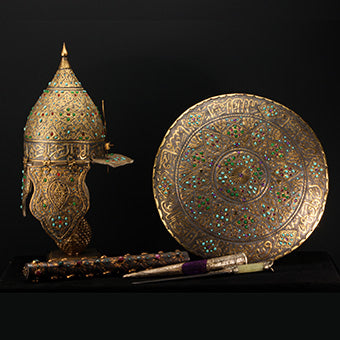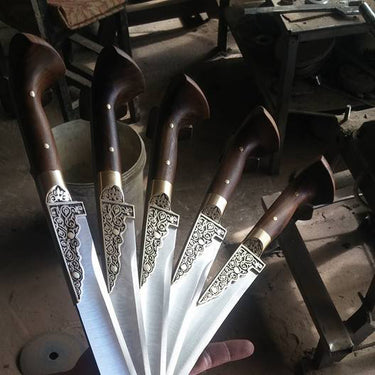-
Kilij
17th century Ottoman Style Kilij Sword . High quality handmade Turkish Kilij Sword with balance, with brass guard.We can engrave names for free upon request. Customizable.For this, it is enough to fill in the engraving text for the front and back of the sword...- $279.00 USD
$299.00 USD- $279.00 USD
- Unit price
- per
Save $20.00 -
Brass Engrave Kilij Sword With Coral and Turquoise Stone
Brass Engrave Kilij Sword With Coral and Turquoise Stone High quality handmade and Hand Engraved Brass Engrave Kilij Sword Eagle Head With Scabbard Only 1 Piece was produced. It is delivered to the courier the same day.When you deliver the sword to the courier,...- $1,600.00 USD
- $1,600.00 USD
- Unit price
- per
-
Brass Engrave Kilij Sword With inlaid Stone Scabbard
Brass Engrave Kilij Sword With inlaid Stone Scabbard High quality handmade and Hand Engraved Brass Engrave Kilij Sword Eagle Head With Scabbard Only 1 Piece was produced. It is delivered to the courier the same day.When you deliver the sword to the courier, you...- $850.00 USD
- $850.00 USD
- Unit price
- per
-
Brass Engrave Kilij Sword Eagle Head With Scabbard
Brass Engrave Kilij Sword Eagle Head v High quality handmade and Hand Engraved Brass Engrave Kilij Sword Eagle Head With Scabbard Only 1 Piece was produced. It is delivered to the courier the same day.When you deliver the sword to the courier, you automatically...- $750.00 USD
$850.00 USD- $750.00 USD
- Unit price
- per
Save $100.00 -
Brass Engrave Kilij Sword With Scabbard
Brass Engrave Kilij Sword With Scabbard High quality handmade and Brass Engrave Kilij Sword With Scabbard. Only 1 Piece was produced. It is delivered to the courier the same day.When you deliver the sword to the courier, you automatically receive a tracking number and...- $850.00 USD
- $850.00 USD
- Unit price
- per
-
Brass Engrave Kilij With Scabbard Wolf Head
Brass Engrave Kilij With Scabbard Wolf Head High quality handmade and Hand Engraved Brass Engrave Kilij With Scabbard Wolf Head Only 1 Piece was produced. It is delivered to the courier the same day.When you deliver the sword to the courier, you automatically receive...- $850.00 USD
- $850.00 USD
- Unit price
- per
-
Brass Engrave Kilij Sword Wolf Head
Brass Engrave Kilij Sword Wolf Head High quality handmade and Hand Engraved Brass Engrave Kilij Sword Wolf Head Only 1 Piece was produced. It is delivered to the courier the same day.When you deliver the sword to the courier, you automatically receive a tracking...- $750.00 USD
$850.00 USD- $750.00 USD
- Unit price
- per
Save $100.00 -
Brass Engrave Kilij Sword Eagle Head
Brass Engrave Kilij Sword Eagle Head High quality handmade and Hand Engraved Brass Engrave Kilij Sword Eagle Head Only 1 Piece was produced. It is delivered to the courier the same day.When you deliver the sword to the courier, you automatically receive a tracking...- $750.00 USD
$850.00 USD- $750.00 USD
- Unit price
- per
Save $100.00 -
Brass Engrave Kilij Sword Lion Head
Brass Engrave Kilij Sword Lion Head High quality handmade and Hand Engraved Curved Turkish Brass Engrave Kilij Lion Head Only 1 Piece was produced. It is delivered to the courier the same day.When you deliver the sword to the courier, you automatically receive a...- $750.00 USD
$850.00 USD- $750.00 USD
- Unit price
- per
Save $100.00 -
Brass Engrave Kilij Sword
Brass Engrave Kilij Sword High quality handmade and Hand Engraved Curved Turkish Sword Sword. Only 1 Piece was produced. It is delivered to the courier the same day.When you deliver the sword to the courier, you automatically receive a tracking number and you can...- $750.00 USD
$850.00 USD- $750.00 USD
- Unit price
- per
Save $100.00
Customer Service +905350522915
Free shipping on Orders Over $99
Recently Viewed Products
Example product title
- $19.99 USD
- $19.99 USD
- Unit price
- per
Example product title
- $19.99 USD
- $19.99 USD
- Unit price
- per
Example product title
- $19.99 USD
- $19.99 USD
- Unit price
- per
Example product title
- $19.99 USD
- $19.99 USD
- Unit price
- per
Example product title
- $19.99 USD
- $19.99 USD
- Unit price
- per
Example product title
- $19.99 USD
- $19.99 USD
- Unit price
- per
Example product title
- $19.99 USD
- $19.99 USD
- Unit price
- per
Example product title
- $19.99 USD
- $19.99 USD
- Unit price
- per
Example product title
- $19.99 USD
- $19.99 USD
- Unit price
- per
Example product title
- $19.99 USD
- $19.99 USD
- Unit price
- per
- Choosing a selection results in a full page refresh.


































